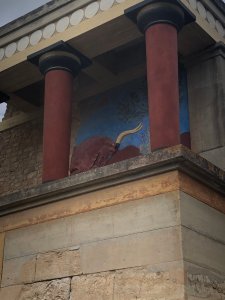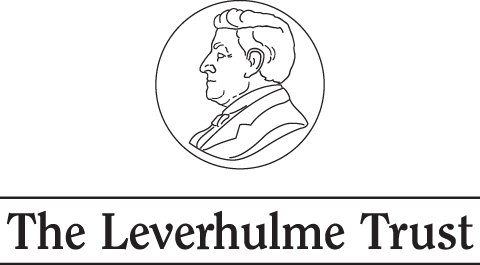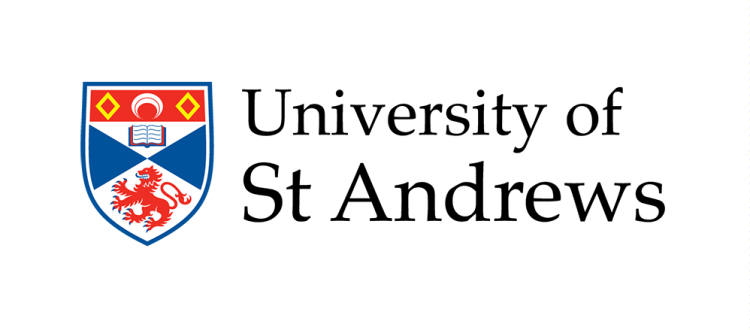Nikos the Cretan
 by Anna Coopey
by Anna Coopey
Through the kind provision of the Laura Cook Memorial Travel Scholarship, given to me by The University of St Andrews School of Classics Travel Scholarship Committee, I was able to travel to Crete in May 2022 in order to undertake some research on Nikos Kazantzakis and his radical receptions of classical antiquity. The trip was planned between February, when I received the scholarship, right up until the last few weeks before take-off, with the help of Lewis Owens, a fantastic academic and all-round great guy, whom I got talking to after a chance encounter on Twitter (and whose work on Kazantzakis is well worth a read), his cousin Gareth Owens, the current Associate Director of the Hellenic Mediterranean University and Associate Professor of Hellenic Culture, whom I met mid-way through my time in Crete (more on that later), and the lovely people at the Nikos Kazantzakis Museum.[1] The experience has been mind-blowing, and something for which I am exceedingly grateful. I would love to return and dig some more into the things I discovered.

 From the moment I arrived in Crete, I was struck by just how large Nikos looms in everyday life here. Pretty much every single person I spoke to in Gouves and wider Crete about Kazantzakis knew precisely who he was and reacted with great warmth and excitement whenever he was mentioned. The second the plane taxied up outside the airport, I was greeted with the airport’s name – Heraklion Airport N. Kazantzakis. Waiting for my luggage, I saw a banner for the Nikos Kazantzakis Museum, where I was visiting the next day, in the terminal. Then, getting to Gouves, not only did I discover a road named after him, but I also found a restaurant named after one of his most famous characters, Zorba (Taverna Zorbas), and perhaps his most famous novel Zorba The Greek on the signs of Cretan tourism shops. One taxi driver gleefully played the Zorba soundtrack, composed by famous musician and communist Mikis Theodorakis (1925-2021), when he picked me up from the Kazantzakis Museum in Myrtia. A group of school kids gave me slightly puzzled looks as they left the theatre section of the same museum, where their teacher had been showing them a rather glitzy costume from a production of his Buddha. He seems to reside somewhere in the very fabric of Cretan identity – Kazantzakis defines Crete as Crete defines Kazantzakis.
From the moment I arrived in Crete, I was struck by just how large Nikos looms in everyday life here. Pretty much every single person I spoke to in Gouves and wider Crete about Kazantzakis knew precisely who he was and reacted with great warmth and excitement whenever he was mentioned. The second the plane taxied up outside the airport, I was greeted with the airport’s name – Heraklion Airport N. Kazantzakis. Waiting for my luggage, I saw a banner for the Nikos Kazantzakis Museum, where I was visiting the next day, in the terminal. Then, getting to Gouves, not only did I discover a road named after him, but I also found a restaurant named after one of his most famous characters, Zorba (Taverna Zorbas), and perhaps his most famous novel Zorba The Greek on the signs of Cretan tourism shops. One taxi driver gleefully played the Zorba soundtrack, composed by famous musician and communist Mikis Theodorakis (1925-2021), when he picked me up from the Kazantzakis Museum in Myrtia. A group of school kids gave me slightly puzzled looks as they left the theatre section of the same museum, where their teacher had been showing them a rather glitzy costume from a production of his Buddha. He seems to reside somewhere in the very fabric of Cretan identity – Kazantzakis defines Crete as Crete defines Kazantzakis.
I first journeyed to Myrtia, a small town in the province of Nikos Kazantzakis (once again, the name is inescapable!), and visited the Nikos Kazantzakis Museum there. The museum is an absolute treasure trove for anyone interested in Kazantzakis, consisting of various exhibits on his works, adaptations, politics, personal life, and an extensive space on his Odyssey: A Modern Sequel (1938). It shows Nikos ‘born a son of Crete’, and ‘[become] a man of Struggle’, as its documentary screening tells, and the space is genuinely fantastic. After interrogating Kazantzakis’ fascination with Henri Bergson (1859-1941), who influenced much of his work,[3] and reading excerpts of letters to Kazantzakis from Albert Einstein (1879-1955)[4] and Thomas Mann (1875-1955)[5], I examined a small exhibit on his relationship with Angelos Sikelianos (1884-1951), fellow communist and best friend, and then began delving in on the body of the museum.
The section of the museum that focuses on Kazantzakis’ politics is small, but his politics are scattered throughout the plaques and discussion of his literary works. For example, we find that, while writing his Odyssey, he wrote a collection called the Tertsines, 22 cantos (24 were intended) dedicated to people who influenced his life and writings – including Lenin. We how engaged his writing was in all of his works, but it is perhaps most obvious in his scathing response to Elli Lambridi’s (1896-1970) review of his Odyssey in Neoellinika Grammata (1939), in which he accuses her of ‘attempt[ing] to perform an autopsy on living organisms’.[6] And we learn of his strong emotional, philosophical, and cultural connection to his home soil, Crete, and to the people of Crete, whom he believes never to bow down to misplaced authority.[7] Perhaps most importantly, though, we learn of his view of Odysseus, who becomes, to him, an expression of the Cretan worldview – an explanation and figurehead, perhaps, of the ‘metacommunism’ that Kazantzakis held to throughout his life – as he explains him to Emile Hourmouzios in a letter dated 23rd October, 1943:
When you ask me, for instance, what stance Odysseus takes regarding the problem of the Individual versus the Collective, whatever I answer, it seems to me that the answer narrows Odysseus’ intention, because in doing so I would imprison his cry within a defined, i.e. restricted formulation. This may satisfy the most forward-thinking here and now, but tomorrow or the day after it will seem conservative even to backward thinkers.
I can tell you what stance I take, but Odysseus transcends me. […] Odysseus is a citizen beyond the racial restrictions of every and any future republic. The Cretan Glance does not mean getting rid of Western or Eastern or Ancient Greek culture. It means synthesising all of them, and above all what is new that wells up within us, and living out a new, broader, bolder, and more responsible view of life.[8]
Kazantzakis felt a deeply human connection to his Odyssey. He used this sequel to Homer’s epic to advance his own world-view, to transform Odysseus into a figure of his own world-view, his own ideal of the Cretan character as a vehicle for revolutionary action and change, as indicated by the various class revolutions that Odysseus spearheads in Sparta, Knossos, and Egypt within the text.[9] He wrote various pamphlets on fascism.[10] He also sustained a strong interest in Soviet cinema throughout his life, writing two scripts accepted by the USSR in the 1920s (it is not known whether they were filmed).
The archives also bore fruit concerning Kazantzakis’ relationship with the USSR. For example, he exchanged many letters with Victor Serge (1890-1947), which are difficult to decipher due to Serge’s poor handwriting. He also had a long-lasting relationship with Rachel Minc (1899-1978), unapologetic revolutionary communist and member of the ‘Fiery Circle’ in Berlin during the 1920s and 30s.[11]
 After work in the archives, I then visited the Minoan Palace in Knossos. Excavated by Sir Arthur John Evans (1851-1941) in the early 1900s, the place looms large in Kazantzakis’ works, and, while there is no evidence for such a meeting, Gareth Owens and I both agree that Kazantzakis must have met Evans at some point, and he certainly visited the ruins. However, the most notable part of the ruins for our purposes would be the bull frieze, which Kazantzakis is said to have seen, alongside the flying fish fresco, and which is explicitly stated to have influenced his revolutionary and Cretan outlook.[12] We have ancient ruins, ancient evidence, once again directly influencing a leftist political stance – precisely what we like to see!
After work in the archives, I then visited the Minoan Palace in Knossos. Excavated by Sir Arthur John Evans (1851-1941) in the early 1900s, the place looms large in Kazantzakis’ works, and, while there is no evidence for such a meeting, Gareth Owens and I both agree that Kazantzakis must have met Evans at some point, and he certainly visited the ruins. However, the most notable part of the ruins for our purposes would be the bull frieze, which Kazantzakis is said to have seen, alongside the flying fish fresco, and which is explicitly stated to have influenced his revolutionary and Cretan outlook.[12] We have ancient ruins, ancient evidence, once again directly influencing a leftist political stance – precisely what we like to see!
Then, after a coffee with Gareth at the Historical Museum of Crete (and a very illuminating chat) in Heraklion, I had a wander around (courtesy of Gareth – P.S. thank you!), and thoroughly filled myself in on Cretan history between the 1930s and 1950s, and particularly the war years. The exhibit there on Nikos Kazantzakis and his life is wonderful, as is the website, and the chance to glance into Kazantzakis’ office, preserved in the museum, was wonderful. A glance over the catalogues of his library told me that he knew of André Gide (1869-1951), a fellow ‘fellow traveller’ and former communist in the 1930s, amongst various other Soviet writers, whose books still sit on his shelves, even now, and the notes written in Nikos’ own hand were a treat to read.
A long (and hot) walk up to the grave followed. Kazantzakis’ grave sits near the Venetian Walls of the city of Heraklion, a not-too-steep walk, but certainly a difficult one in the heat. The grave of Kazantzakis’ second wife, Eleni (1903-2004), sits nearby Kazantzakis’, and, when one gazes upon the standing of the cross before the tombstone, one can’t help but believe the rumours of a huge man coming down from the mountains during his burial, straight out of one of his books, and lowering the coffin himself.[13] Kazantzakis’ motto, his epitaph, is engraved on his headstone, and it summarises well his general approach to life, which influenced both his politics and his perception of the Cretan character: I hope for nothing. I fear nothing. I am free.
After this, I visited the Archaeological Museum of Heraklion, which houses artefacts from the excavations at Knossos amongst other collections – a distillation of the ancient Cretan character / evidence that Kazantzakis was so intrigued by. Crete – or, at least, Minoan Crete – becomes a place ‘ripe to be toppled’, and the excavations provide the evidence for that. For me, the image of a crown, uncovered from a burial sight, and embedded into a skull at the eyes, sums up Kazantzakis’ approach to Minos: blinded by his own power, blinded by his gold, blinded by the monarchy.
And that was Crete. The trip was eye-opening, illuminating, something that exposed Nikos at the root. Kazantzakis is irrevocably Cretan, and he is a man who can only be fully understood, both on a personal and a political level, through the place itself.
***
Notes:
[1] For Lewis’ work on Kazantzakis, see especially Owens, Lewis (2001): Metacommunism: Kazantzakis, Berdyaev and ‘The New Middle Age’ from The Slavic and East European Journal, Vol. 45, No. 3, pp. 431-450 and Owens (2002): Creative Destruction: Nikos Kazantzakis and the Literature of Responsibility (Mercer University Press). Also see the Nikos Kazantzakis Project, which Owens was heavily involved with, and which produced a version of Kazantzakis’ Comedy in London in 2014 – https://nikoskazantzakis.org/. For more on Gareth Owens, see his CV at Daidalika’s website – https://daidalika.hmu.gr/author/. Special thanks go to Kostis Kanakis for liaising with me (and for misspelling ‘Communism’ four times)! The website for the Nikos Kazantzakis Museum is here – https://www.kazantzaki.gr/en.
[2] Morton P Levitt says as much in his The Cretan Glance: The World and Art of Nikos Kazantzakis (1972) (from Journal of Modern Literature, Vol. 2, No. 2, Nikos Kazantzakis Special Number (pp. 163-188) (Indiana University Press)).
[3] On Bergson’s influence in Europe see Antliff, Mark (2014): From Class War to Creative Revolution: Bergson’s Communist Legacy in Britain from Annales Bergsoniennes VII (pp. 235-258) (Cairn).
[4] The following accessed at the Nikos Kazantzakis Museum, Myrtia – Letter from Albert Einstein to Kazantzakis, dated July 2nd, 1952: ‘Dear Mr Kazantzakis, I thank you very much for sending me the German translation of your work. I can imagine that the tragic fate of your people is the source of its origin. There was unspeakable suffering produced probably entirely by power politics, enacted by one big power after the other and no end of it is in sight. It seems the inescapable fate of man to make each others [sic] life intolerable. Thankfully yours, Albert Einstein.’
[5] The following accessed at the Nikos Kazantzakis Museum, Myrtia – Letter from Thomas Mann to Kazantzakis, dated April 7th, 1952: ‘Dear Mr. Kazantzakis, I received your novel GRIECHISCHE PASSION with the beautiful hand-written inscription, and have read it with sincere emotion. The novel is without doubt a work of high artistic order, formed by a tender and firm hand, and built up with strong dynamic power. I have particularly admired the poetic tact in phrasing the subtle, yet unmistakeable allusions to the Christian Passion play. They give the book its mythical background which is such a vital element in the epic form today. You should not speak of loneliness as you do in your inscription. Your personal life may be lonely, but the commentaries on your work show that spiritually you are surrounded by sincere friends and admirers of your views and your great accomplishment. Please accept my best wishes for the future. Most cordially yours, Thomas Mann.’
[6] Elli Lambridi’s review was as follows: ‘The Odyssey is like a dense thicket – once you have entered, you lose your sense of direction and hack a path as it suits you. This thicket has no external outline to it; in other words, it does not want to leave anything out on the outside to help you to fix boundaries between what it is and whatever alien things do not interest it. For that reason, this study of mine is only by way of a first ground reconnaissance, which is definitely incomplete and definitely subjective.’ (translation accessed at the Nikos Kazantzakis Museum in Myrtia)
[7] See a letter sent by Kazantzakis to Emile Hourmouzios, affectionately called Militos, from Aegina on the 23rd May, 1943: ‘Please pay attention to whatever I write about ‘Crete’ as I experience it within me, and which philosophical meaning I lend to Crete (a synthesis of Greece and the East). Neither Greece nor the East: Crete. That is the key to entering the Odyssey. If that is well explained, the Odyssey becomes plain and simple. Minoan Crete with its terrible earthquakes symbolised by the bull, and by the games that Cretans play with that very bull, expresses what I say: to look into the abyss and not be frightened; on the contrary, to fight and play with the abyss at your ease. That is what I call the Cretan glance. That way, I think, my soul is clearly illuminated for the first time, as the continuation of a primeval force that first broke out on Crete and still exists.’
[8] Translation accessed at the Nikos Kazantzakis Museum in Myrtia.
[9] As written in the museum itself: ‘Kazantzakis’ entire intellectual life, his Weltenschauung and the questions to which he sought answers for many years are panoramically laid out in the 33,333 lines of his Odyssey. The main thematic motif is the journey, and the main thesis is on gaining freedom. The protagonist – a distant descendent of Homer’s Odysseus – is the incarnation of the ‘last man of old’. An eternal traveller and perpetual migrant, he rebels without fear or hope against the decline of the world, enslavement and the tyranny of matter, in search of the meaning of life and pure, absolute freedom.’
The revolutions were indeed particular points of interest for reviewers, and particularly in France in the 1970s, as seen by a review of a French translation in Figaro on 21st January, 1972 (En Route avec l’Ulysse de Kazantzaki).
[10] Of particular note is his Fear and Hunger, an article on the rise of fascism from Kathimerini (20-07-1936).
[11] For more on Minc and other fantastic women, see Tagopoulos, Constance (2010): Woman as Symbol in Kazantzakis’ Writings from Journal of Modern Greek Studies, Supplement to Vol. 28, No. 1 (pp. 219-240) (Johns Hopkins University Press).
[12] As written at the Nikos Kazantzakis Museum in Myrtia: ‘The ‘Cretan Glance’ with which all of Kazantzakis’ heroes are endowed is a particular moral stance, best summed up as the absence of fear and hope in the face of futility, the abyss and death. Kazantzakis conceived of it in a vision, while looking at the Minoan bull leaping fresco, and believed that it resulted from the synthesis of diverse cultures and opposing perceptions. In Spain, where Arab and Western culture also intersected, he had found a similar stance towards life, which he described as a synthesis of passion and nothingness.’
[13] See Levitt, Morton P (1972): The Cretan Glance: The World and Art of Nikos Kazantzakis (p. 164) (Indiana University Press).




